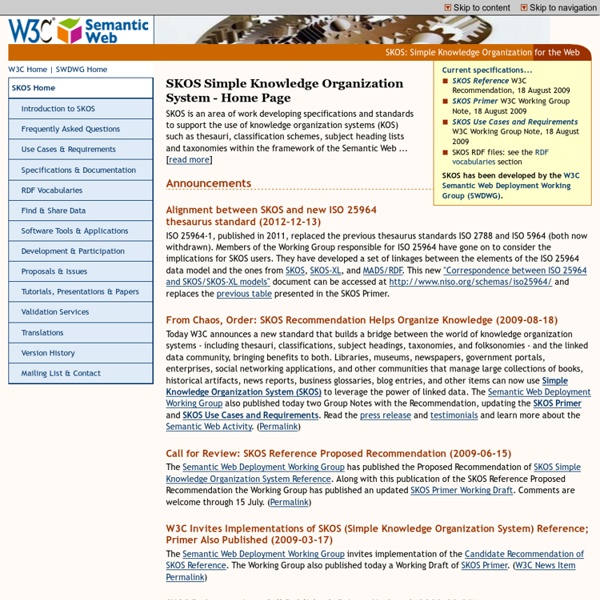What is the Structured Web?
The structured Web is object-level data within Internet documents and databases that can be extracted, converted from available forms, represented in standard ways, shared, re-purposed, combined, viewed, analyzed and qualified without respect to originating form or provenance. Over the past few months I have increasingly been writing about and referring to the structured Web. I have done so purposefully, but, so far, with little background or explication. With the inauguration of this occasional series, I hope to bring more color and depth to this topic [1]. Literally, over the past year, I have been learning and documenting on AI3 my attempts to understand the basis, concepts and tools of the emerging semantic Web. In that process, I have come to define my own outlines of the Web past, present and future.
Alex Faaborg - » Microformats - Part 0: Introduction
Have you been over hearing people talk about microformats and thought to yourself “what are those?” In this post I provide a quick introduction, and discuss the various ways that microformats are changing the Web. What are microformats?
OWL
The OWL Web Ontology Language is designed for use by applications that need to process the content of information instead of just presenting information to humans. OWL facilitates greater machine interpretability of Web content than that supported by XML, RDF, and RDF Schema (RDF-S) by providing additional expressive power along with a formal semantics. The group's work is complete with the publication of OWL 2 (Second Edition).
Protocol
Jump to: XML tag definitions Entity escaping Using Sitemap index files Other Sitemap formats Sitemap file location Validating your Sitemap Extending the Sitemaps protocol Informing search engine crawlers This document describes the XML schema for the Sitemap protocol. The Sitemap protocol format consists of XML tags. All data values in a Sitemap must be entity-escaped. The file itself must be UTF-8 encoded.
Labs/Ubiquity
Back to Labs. Ubiquity was a Mozilla Labs experiment that was in development from 2008 to 2009. Its purpose was to explore whether a radically different type of interface to the Web — a task-centric, natural-language-based command line — could help us get common Web tasks done faster. Development is currently on indefinite hiatus.
RDF - Semantic Web Standards
Overview RDF is a standard model for data interchange on the Web. RDF has features that facilitate data merging even if the underlying schemas differ, and it specifically supports the evolution of schemas over time without requiring all the data consumers to be changed.
RDFa Lite 1.1
Status of This Document This section describes the status of this document at the time of its publication. Other documents may supersede this document. A list of current W3C publications and the latest revision of this technical report can be found in the W3C technical reports index at This is an Editorial Revision of the Recommendation published on the 7th of June, 2012.
XFN - XHTML Friends Network
XFN™ (XHTML Friends Network) is a simple way to represent human relationships using hyperlinks. In recent years, blogs
À propos de data.bnf.fr (data.bnf.fr)
Current Version This site, which has been available online since July 2011, is continuously being developed and undergoes regular updates. The version currently displayed is Version [1.3] of data.bnf.fr, posted online on 2014/03/25. How to retrieve data from data.bnf.fr: download the data.bnf.fr dump file as of 2014/03/25. Summary:
Defining the Semantic Web in a Few Sentences
A Quora user posed this challenge to the network: “How do you explain semantic web to a nine-year old child in one sentence?” The challenge was followed by a quote from Albert Einstein: “If you can’t explain it to a six year old, you don’t understand it yourself.” Some of the best responses so far include, “A web where computers better understand the real meaning of the words we use to communicate with them.”
new pearl
The Semantic Web is a web of data. There is lots of data we all use every day, and it is not part of the web. I can see my bank statements on the web, and my photographs, and I can see my appointments in a calendar.
Time Ontology in OWL
Abstract This document presents an ontology of temporal concepts, OWL-Time (formerly DAML-Time) [4,10], for describing the temporal content of Web pages and the temporal properties of Web services. The ontology provides a vocabulary for expressing facts about topological relations among instants and intervals, together with information about durations, and about datetime information. We also demonstrate in detail, using the Congo.com and Bravo Air examples from OWL-S [11], how this time ontology can be used to support OWL-S, including use cases for defining input parameters and (conditional) output parameters. A use case for meeting scheduling is also shown. In the appendix we also describe a time zone resource in OWL we developed for not only the US but also the entire world, including the time zone ontology, the US time zone instances, and the world time zone instances.
Twinkle: A SPARQL Query Tool
Twinkle is a simple GUI interface that wraps the ARQ SPARQL query engine. The tool should be useful both for people wanting to learn the SPARQL query language, as well as those doing Semantic Web development. Twinkle was originally inspired by Elliotte Harold's XQuisitor which provides a simple GUI interface for playing with XQuery. Features Load, edit and save SPARQL queries Insert PREFIX statements into queries Configure custom namespaces so they can be quickly inserted into queries Cancel long running queries Save results to file Query local files and remote RDF documents Query RDF data held in relational databases Query online SPARQL endpoints, such as DBpedia, reyvu.com and GovTrack. Query using standard SPARQL, or the ARQ extended syntax which supports COUNT, etc.



